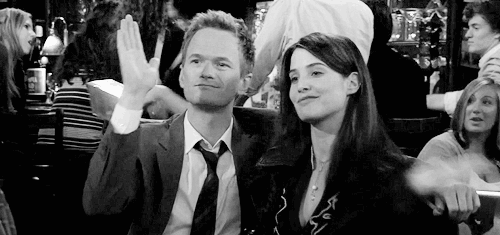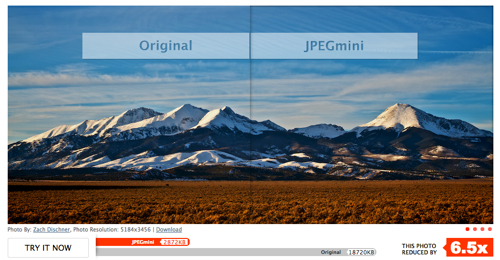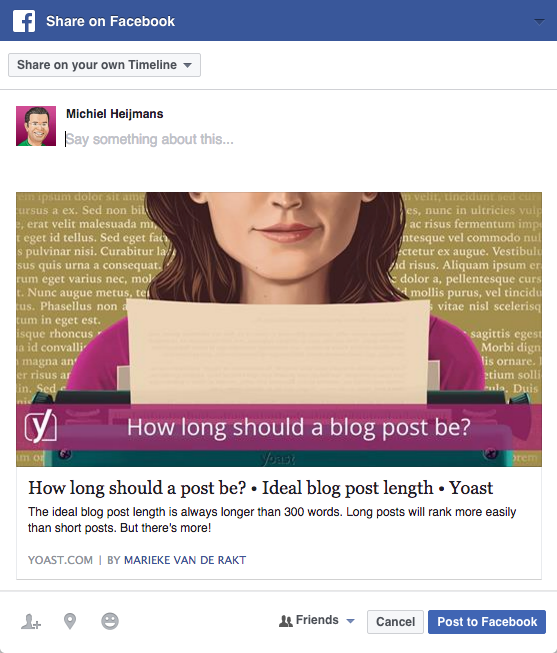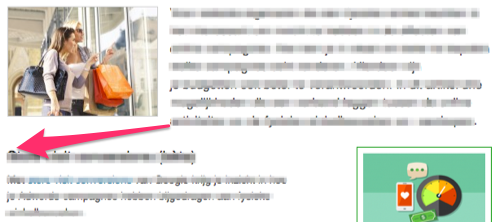[轉載] Optimizing images for SEO Back
- Author: Michiel Heijmans
- Origin: https://yoast.com/image-seo/
- Time: Oct, 12nd, 2016
If you are for instance a blogger or write articles for an online magazine or newspaper, you encounter this question on a probably daily basis: should I add an image to my article? The answer is "Yes". Images make an article more vivid and can actually contribute to improving the SEO for your article. In this post, I'd like to explain the steps that should be taken to fully optimize an image for SEO.
When optimizing an image you make sure it as small as it can be in terms of download size by using the right image compression. A well-optimized image also has the right name and alt text, so it's optimized for search engines too.
Use images
Images, when added with a certain consideration, will help understand your article a lot. "A picture is worth a thousand words". Yeah, well, probably not for Google, but it can for sure spice up a 1,000 dull words, illustrate what you mean in a chart or data flow diagram, or simply make your social media efforts more attractive.
It's a simple recommendation: use images to every article you write online. It'll make it more appealing.
Finding the right image

If you have the opportunity to add your own image, please do so. Your team page needs pictures of your team, not this dude on the right or one of his stock photo friends. Off topic: let alone that the dude might need a haircut.
Your article needs an image that has the same subject as your article. If you would use an image, just to use an image and get a green bullet in our SEO plugin, you are doing it wrong. The image should reflect the topic of the post, or have illustrative purposes within the article, of course.
There is a simple image SEO reason for that: an image that is surrounded by related text, ranks better for the keyword it is optimized for. More details on image SEO later.
You might have seen the images we are using for our posts (the ones with the titles). We have added these for a number of reasons:
- They emphasize the title or subject of the post
- It'll trigger a visitor to read the post, as the first view isn't just text
- These images are used in OpenGraph tags and Twitter Cards, which will add the image to our social shares.
Just another way to go about adding images. By the way, most of these 'featured images' are stock photos. We have made them our own by adding the title in the same way over and over, making the actual image subservient to the text in the image. That goes against a much-heard recommendation to not add text in images, but as mentioned, we use that specific image for other purposes, not per se for SEO.
If there is no way to use images of your own, there are other ways to find more unique images and refrain from using stock photos. Flickr.com is a nice image source for instance, as explained in this article: How to Use Creative Commons Images from Flickr. I also like the images provided by sites like freeimages.com (formerly known as sxc.hu). Check here for more image resources. You should stay away from the obvious stock photos, and rather pick the ones that look (ok, just a bit) more genuine. It almost seems like images with people always look like stock photos, unless taken by yourself. In the end, that is still the best idea.
Obvious alternatives for photos could be illustrations, like we sometimes use, or graphs, of course. An honorable mention should go to animated GIFs, as these seem to become more and more popular these days.

Animated GIFs are very popular these days. Don't go overboard. It'll make your post less attractive to read, as your reading will be interrupted by the movement in the image, of course. Like in the post where I found the above image.
Preparing images for use in your article
When you have found the right image to use, either an illustration, chart or photo, the next step is to optimize that image for use on your website. There are a number of things to take in consideration:
Choose the right file name
Image SEO starts with the right file name. Of course this is the first location to use that keyword. Without even looking at the actual image, you want Google to know what the image is about. It's simple: if your image is a sunrise in Paris showing the Notre Dame, the file name shouldn't be DSC4536.jpg, but notre-dame-paris-sunrise.jpg. The main keyword would be Notre Dame, as that is the main subject of the photo, that is why I added that at the beginning of the file name.
Scale for image SEO
Loading times are an important UX and therefore SEO aspect. The faster the site, the easier to visit and index a page is. Images can have a huge impact on loading times, especially when you load a huge image and show it really small, like using a 2500×1500 pixels image and showing it at 250×150 pixels size. The entire image will still have to be loaded. Scale the image to the size you want to show it. WordPress helps by providing the image in multiple sizes after upload already. Unfortunately that doesn't mean the file size is optimized as well, that's just the image size.
Reduce file size
The next step in image SEO should be to make sure that scaled image is served in the smallest file size possible. There are tools for that. Of course you could just export the image an test what percentage of quality is acceptable, but I prefer (especially with retina and similar screens) to use 100% quality images.

Optimize image file size for instance using JPEGMini
You can still reduce the file size of these images by for instance removing the EXIF data. We recommend using tools like ImageOptim or websites like JPEGMini or PunyPNG. I've also heard great stories about Kraken.io, but I haven't used that myself, to be honest.
After you have uploaded the image, tools like YSlow can tell you if your image optimization succeeded.
Adding the image to your article
Don't just stuff it in somewhere. I already mentioned adding it near / at / in related textual content. That simply helps a lot. It makes sure the content is relevant for the image as well, as it is the other way around.
Captions
The caption of the image is the text that accompanies the image. At most images in this article, it's the text in the gray box below it. Why is that text important for image SEO as well? People use that text in scanning an article. Next to headings, people tend to scan the image and include the caption as well in that scan. Nielsen actually wrote back in 1997: "Elements that enhance scanning include headings, large type, bold text, highlighted text, bulleted lists, graphics, captions, topic sentences, and tables of contents." In 2012, KissMetric even stated that "Captions under images are read on average 300% more than the body copy itself, so not using them, or not using them correctly, means missing out on an opportunity to engage a huge number of potential readers."
Do we add captions to all images? No. As mentioned, sometimes images just serve another purpose. Decide whether the image at hand is an image you want to use for SEO as well or not. Keeping over-optimization in mind, I'd say you should add a caption if it would make sense to the visitor if that caption is added. Think about the visitor first, don't add a caption just for image SEO.
Alt text and title text
The alt text is added to an image so there will be a descriptive text when the image for whatever reason can't be displayed to the visitor. I can't put it any better than Wikipedia: "In situations where the image is not available to the reader, perhaps because they have turned off images in their web browser or are using a screen reader due to a visual impairment, the alternative text ensures that no information or functionality is lost." Be sure to add alt texts. Make sure the alt text includes your SEO keyword and relates to / describes the image.
When hovering an image, IE shows the alt text as a 'tooltip'. Chrome show the title text, like it was intended. Title text for images is similar and a lot of people that use these simply copy the alt text. More and more people simply leave these out. What is it for? "The title attribute can be very useful, but it is not a safe way of providing crucial information. Instead it offers a good way to provide non-essential information, for example the mood of the image, or what it means in context." it's nice to have information indeed, and isn't taken in account for image SEO.
Read more: 'Image SEO: alt tag and title tag optimization' »
I mentioned using the image for social sharing. If you add the right image tag to your <head> section like this:
<meta property="og:image" content="http://example.com/link-to-image.jpg" />
That will make sure the image is included in your share on Facebook (and OpenGraph is also used for Pinterest, for instance).

Our WordPress SEO plugin has a Social section where you can set and preview this image. Make sure to use a high-quality image, like the original image you use in the post, as higher quality / larger images tend to be used by the social platforms more often. If you have set this up correctly, and it doesn't work, try to flush Facebook's cache in the URL Debugger.
Twitter Cards do the same for Twitter, and are also generated by our plugin.
Alignment
Let me be honest, this is a pet peeve of mine. Images shouldn't break the left reading line. I'm sure there are studies about this but I'm taking full responsibility for this myself: I just really don't like it when text starts on the right of an image, only to jump below the image later:

Maintain the left reading line; don't align images to the left
If an image is used that is the same width as your textual column, that would be no problem. It will even help emphasizing the image more.
Note that this has absolutely nothing to do with image SEO, but I saw an opportunity to express my opinion and used it :) I think it's bad for user experience. Just to please me: don't. Thanks a lot for that.
XML image sitemaps
If you are a web developer, you might wonder about XML image sitemaps. I'd rather say images in XML sitemaps. Google is pretty clear about this:
To give Google information about images on your site, you'll need to add image-specific tags to a sitemap. You can use a separate sitemap to list images, or you can add image information to an existing sitemap. Use the method works for you!
Every now and then, people ask us about XML image sitemaps. We don't generate these in our plugin, but as Google states, instead these images are included in the page or post sitemaps. Just scroll down in our post sitemap and find that we have added images to all our latest posts (there is a column telling you that). Adding images to your XML sitemaps help Google index your images, so be sure to do so for better image SEO.
TL;DR
Image SEO is the sum of a number of elements. With Google being able to recognize elements in the image better every day, it makes sense to make sure the image and all elements contribute to user experience as well as SEO. It would be foolish to try to fool Google.
Take these things in mind when adding an image to an article:
- Use a relevant image that matches your text
- Pick the right file name for your image
- Make sure image dimension match the image size as displayed
- Reduce file size for faster loading
- Add a caption for easier scanning of the page
- Use an image alt text, title text is optional
- Add OpenGraph and Twitter Card tags for the image
- Don't break the left reading line using an image
- Use images in your XML sitemaps
Next to image SEO and using images for user experience, images can also play an important role in conversion!
As the plugin is integrated with a code management system like GitLab or GitHub, you may have to auth with your account before leaving comments around this article.
Notice: This plugin has used Cookie to store your token with an expiration.